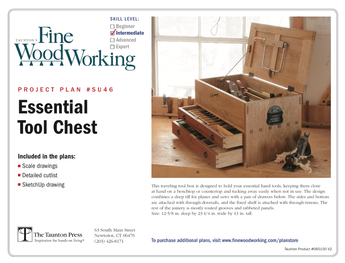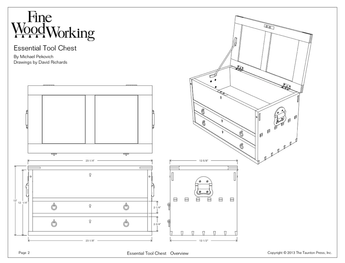Over on a Canadian Forum there was some discussion regarding some light duty clamps break. This of course led to a discussion regarding clamping pressure and PVA glue. One of the guys did a pseudo scientific test attaching two blocks to a center block, one clamped and the other just rubbed. He then used his bench vise to pull it all apart. He performed the test twice, in both cases the rig failed at the unclamped joint.
(Here is the blog post: http://ifonlyyouwood.blogspot.com/2009/08/clamping-for-pva-glue.html)
I think he extends his conclusion a bit too far (he never actually tested moderate clamping pressure), but it’s interesting none the less.














Replies
There is plenty of more than pseudo scientific testing on glue clamping pressure, since it is an issue of some consequence for industrial users of glued up wood. One article in FWW was based on such research and received a lot of attention here on knots.
R. Bruce Hoadley in Understanding Wood (which should be required reading for all more than casual woodworkers) also presents similar data.
Glue manufacturers have also weighted in. You can see optimum glue pressures for Titebond glues on the company's web pages.
The concensus concerning gluing PVC type glues is that HEAVY glue pressure yields the strongest results. It is essentially a myth that you can squeeze out too much glue with clamps applied by hand.
Glue joints likely become adequately strong for most purposes at clamp pressures well below optimum, but that's not really an argument against using heavy clamping force. To get to excessive force you probably have to apply so much pressure that the wood at the glue line is permanently deformed.
I'm with you, I clamp hard. I actually don't even know why the question of clamping force comes up. As you pointed out all the experts point to high pressure.
I remember the FWW article well. It generated as much controversy for the max pressure from each type of clamp. The idea to calculate how much pressure was needed is way overkill for home applications, but that doesn't imply we don't need high pressure. In the recent issue of another 'Popular' Woodworking magazine the editor refers to this article and states that it flies in the face of everything he knows about woodworking**... Which is a pretty dramatic.
** I'll check the exact quote later, as I don't have it here.
Anyway I just found the test pretty interesting.
I take a different view on this, if an edge to edge joint is properly fitted it should only need light pressure to make the joint close completely and evenly over its entire length.
Any glue up job that needs heavy pressure and/or is pushing the clamps to their breaking point hasn't been prepared properly.
John White
Shop Manager for FWW Magazine, 1998-2007
I strongly agree that well fitted joints take little pressure to close the joint. For critical panels glue ups it is reasonable to aim for joints that take only light hand (no clamp) pressure to eliminate all light passing between the boards. That's how I was taught. You are exactly right that firm clamping isn't a substitute for proper joint preparation.
But that's not the issue being addressed. The glue line itself needs to be quite thin, both for invisibility, and for the strength of the joint. And it's clean, well fitted wood surfaces that have been tested to create the recommended pressures. Glue lines of more than a couple of thousands of an inch can cause particular problems of creating stresses when the glue dries, according to Hoadley. Getting the ideal thin and even glue line is where the heavy pressure comes in, not pulling badly fitted joints together.
Of course, one shouldn't make too big an issue with this. As I mentioned initially, glue joints can work just fine at less than optimal strength. But there just isn't reason for the advise sometimes heard to just "clamp just hard enough to get a little squeeze out from the joint" often followed by the admonition "don't starve the joint."
And, it should be mentioned that not all glues are the same. Epoxy for example, apparently works well with thicker glue lines and shouldn't be clamped as hard. I Hide glue, while firm is still good, probably needs less than PVA for optimum strength. Afterall, hide glue can work OK, perhaps not "optimally", with just a rubbed joint, at least if well done.
Well let me say this about that :It seems to me that glue with water in it such as hide and PVA tends to cause the joint to draw together some as it dries. For a very rough example; if you put a bead of glue on the wood the bead it will shrink and shrivel as it dries.Anyway what I am getting at is on thinner work ~ 3/8 I have done rubbed joints ( no clamps ) on extremely good fitting, freshly hand planed, panel edge glue ups and the joint just disappeared. No glue line. I bet if I broke it it would break in the wood and not in the glue line.I wouldn't get that kind of success with epoxy or Gorilla. Gorilla expands with the moisture.rocGive me six hours to chop down a tree and I will spend the first four sharpening the axe. Abraham Lincoln ( 54° shaves )Edited 8/28/2009 12:45 am by roc
Edited 8/28/2009 12:46 am by roc
The clamps were ultra light duty. Light enough I didn't bother buying any and they were very cheap.
High clampping pressure will not make up for poor edge preparation, but a good edge doesn't necessarily mean we only need minimal clamping.
This forum post is now archived. Commenting has been disabled